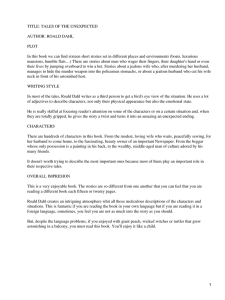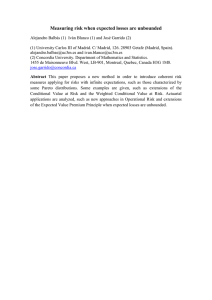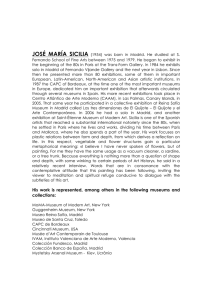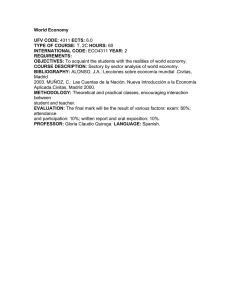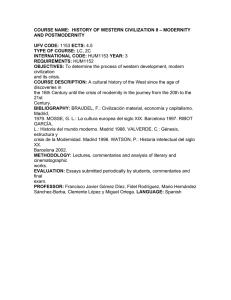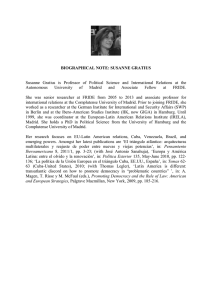Further Considerations of History and Law in the Wife
Anuncio
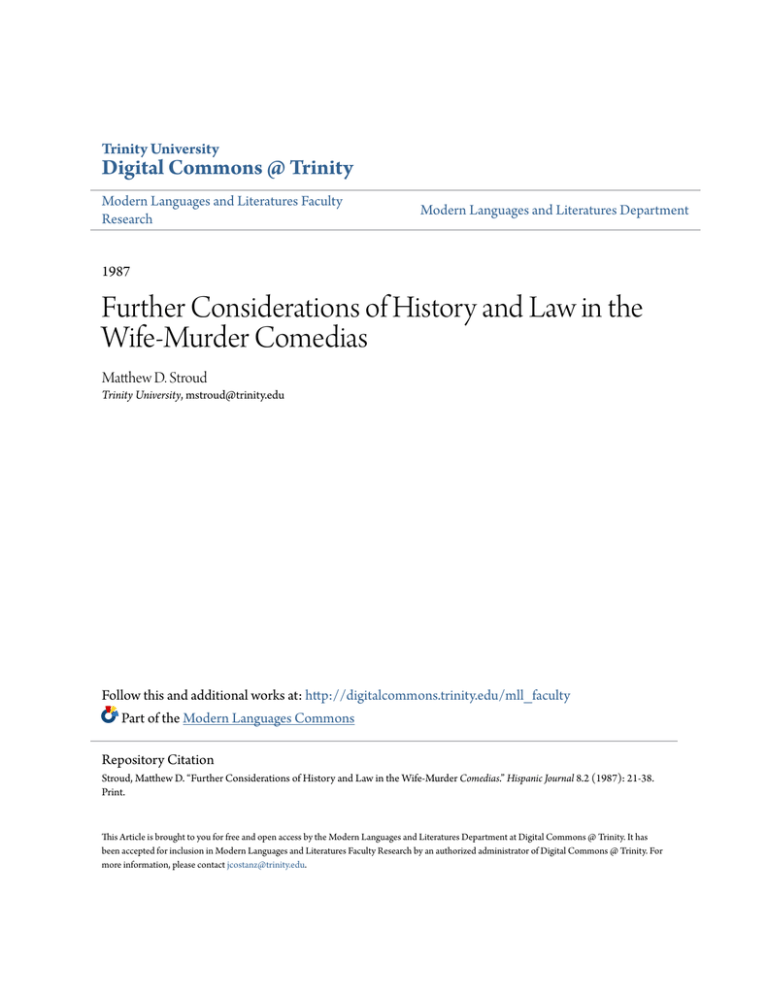
Trinity University Digital Commons @ Trinity Modern Languages and Literatures Faculty Research Modern Languages and Literatures Department 1987 Further Considerations of History and Law in the Wife-Murder Comedias Matthew D. Stroud Trinity University, [email protected] Follow this and additional works at: http://digitalcommons.trinity.edu/mll_faculty Part of the Modern Languages Commons Repository Citation Stroud, Matthew D. “Further Considerations of History and Law in the Wife-Murder Comedias.” Hispanic Journal 8.2 (1987): 21-38. Print. This Article is brought to you for free and open access by the Modern Languages and Literatures Department at Digital Commons @ Trinity. It has been accepted for inclusion in Modern Languages and Literatures Faculty Research by an authorized administrator of Digital Commons @ Trinity. For more information, please contact [email protected]. FURTHER CONSIDERATIONS OF HISTORY AND LAW IN THE WIFE-MURDER COMEDIAS Those who, like Americo Castro and Arnold Reichenberger, assume a great similarity between historical fact and dramatic action, use literary texts to posit speculations about historical fact and historical fact to assert the realism of literary situations. 1 Despite the potential tautology inherent in such arguments, these scholars have attempted to prove their cases by bringing to bear the following evidence: 1) real wife murders documented in Spanish history; 2) laws regarding the punishment of an adulterous wife 3) Spanish social history and the formation of a national Spanish personality; 4) contemporary concepts of honor, some fictional and some didactic, that together have come to be known as the honor code; 5) human nature («What husband would not feel the same about an adulterous wife and act accordingly?» [Parker, «Towards» 237]); and 6) wife-murder plays based on historical Spanish incidents. Two general and contradictory conclusions of these studies are 1) that the wife-murder plays represent a particularly Spanish genre that grew out of a peculiar Spanish historical and social reali­ ty, 2 and 2) that the wife-murder plays reflect the universal situation of the aggrieved husband who responds violently but appropriately to his wife's adultery. 3 Clearly, both wife murder and plays about wife murder existed in Golden Age Spain. Numerous studies have documented the historical evi­ dence of Spanish uxoricide found in the Cronica general, the Cartas de al­ gunos PP, de Ia Compafifa de Jesus, the annals of various cities, the A visos of Pellicer and Barrionuevo, and so on. 4 However, the mere fact that such murders existed is not enough to prove once and for all the reliability of the comedia as a speculum vitae. Although she represents a minority opinion in the criticism, McKendrick notes that many claims to wife murders were un­ reliable, being based more on masculine boasting than fact, and that public sympathy almost always lay with the victims (McKendrick 37-39). To sup­ port her assertion regarding public sympathy, McKendrick cites the Fajardo case as well as a letter in the Cartas de los PP, Jesuitas (18: 88) mentioning a case in which women rose up in anger after a wife murder and the authorities had to hang the murderers to restore order. 21 22 HISPANIC JOURNAL Too, the number of known wife murders over the four hundred years in which they occurred is actually quite small. One indication of the fre­ quency with which Spaniards attempted wife murder is the occurrence of such cases in the Archivo Hist6rico de Toledo, now housed in the Archivo Hist6rico Nacional in Madrid, Section Two, «Ordenes Militares» (see Rodriguez Marin). In the Calatrava section containing 1 5,033 cases con­ cerning members of that order, only nine involved wife murder between the years 1550 and 1690. To show the variety of real wife-murder and to bring to light these heretofore unmentioned cases, let us briefly cite them. Legajo 35248 concerns the case of Crist6bal Rojo, who was found guil­ ty of having stabbed to death his wife, Maria Ramirez, in 1674. After an ini­ tial imprisonment, he was sentenced to death, but on appeal the sentence was changed to payment on a fine. Legajo 35447 deals with the murder of Ana L6pez by her husband, Crist6bal Moreno, for adultery in 1656. More­ no received a sentence of two years of imprisonment, two years of exile, and payment of a fine. Legajo 39423 notes the 1594 stabbing death of Marfa Hernandez by her husband, Sim6n Sanchez, «por dezir abia hallado ael cu­ ra de Ia dicha villa con ella.» The disposition of the case is unstated. Legajo 39614 concerns the 1582 murder of Francisca Ia Vaquera by her husband, Valentin Ruiz, and his subsequent assessment of a fine of 10,000 maravedis. Ruiz later sued the Fiscal for having accused him of killing his wife (legajo 4 1 843). Legajo 43568 contains documents relative to the case against Agustin Gasc6n, who killed his wife in 1561 for suspicion of adultery. Lega­ jos 46265-68 involve the charges against Clemente de Villavicencio who killed his wife, Maria de Villavicencio, in 1666. His fine was 10,000 ducats. Legajos 45699-701 relate the 1662 murder of Juana Cejuedo by her hus­ band, Jer6nimo de Mendiola. Legajo 46037 concerns the murder of Loren­ za Martinez by Vicente Nieto. This 1 668 case involves not only wife murder but abortion. Legajo 46277 tells of the 1682 murder by Gabriel Romero of his wife, Manuela Poblete. 5 One additional case involved a failed attempt at wife murder (legajo 36425). One would think that if wife murder were a socially approved activity, that there would be many more instances in the century and a half covered by these cases. These documents provide incontrovertible evidence of the fact that wife murder did occur, but the small number of cases (9 out of more than 15,000 over 140 years) can hardly be said to represent a wide­ spread social practice. McKendrick (26) cites Pinheiro (Pincigrajfa, in Fati­ ginia o jastos generales, trans. Narciso Alonso Cortes jValladolid: Imp. del Colegio de Santiago, 1916, 209?): « Y asf no hay muertes de mujeres sino ra­ ramente.» In fact, we should probably assume that wife murder was, as it is in current American society, a phenomenon common enough to come to the attention of a large part of the society, but still rare enough to cause for sur­ prise, shock, or scandal (Cf. Dixon, «EI castigo» 64). HISTORY AND LAW IN THE WIFE-MURDER COMEDIAS 23 The Jaw has also been used to support the connection between litera­ ture and reality. As with the wife murders themselves, there is no doubt that there were indeed laws that allowed the husband to kill his wife for adultery. 6 Most of the fueros and cartas stated unequivocably that if adultery was proven against a wife and another man, both the wife and the man were to be turned over to the custody of the husband so that he might then expect whatever price or punishment he saw fit. 7 However, death of the guilty parties was not obligatory, although if he killed one of the lovers, he usually should kill the other. 8 The use of the Jaw to assert the close connection between literature and reality fails on several grounds. Other laws did not allow the husband to kill his wife for adultery, the most notable of which appears in Alfonso X's Par­ tidas 1. 17. 13, which strictly prohibits a man from killing his wife even if he kills her lover. Rather, the wife was either to be pardoned or sent to a con­ vent for life, or, under other legal authorities, the adulterers were to be whipped or humiliated.9 McKendrick (36) states specifically that the honor code did not have the sanction of law, despite its alleged importance to social behavior: · «Convicted wife murderers were subjected to harsh penalties , as Lope shows in a melodramatically phrased remark in a letter to the Duke of Sessa, 'No hazen sino encubar honbres porque matan a tanto que en dos dias, que xamas sus mujeres, se ha visto, han sacado dos, a cuya fiesta ha salido ai rio toda Ia Corte en coches, en caballos y en mula de alquiler.'» (Citing Lope de Vega en sus cartas, ed. A.G. de Amezua jMadrid: Tip. de Archivos, 1935-43, 3: 80) All the Calatrava cases that indicate the husband's fate also note that he received some form of punishment, if only payment of a fine. While outrageously light by today's standards, such penalties do indicate that a husband's murder of a wife was not the socially acceptable recourse we find in some plays. Moreover, even if we grant the legal right to kill one's adulterous wife, the evidence supporting like punishment for the suspicion of adultery is considerably less convincing. IO In addition, by the reign of Phillip II, a husband would most certainly not have been allowed to carry out his punishment without going through legal channels. 1 1 The Calatrava cases mentioned above show the thorough­ going, bureaucratic nature of legal investigations; legajo 35248 runs ap­ proximately 375 pages, and some files are even longer. In fact, the famous secrecy component of the honor code is contrary to the very basis of law and justice, even royal and manorial law (Berman 325-27, 423-24, 512-13). If the real murders had been secret, not only would justice not have been served even under, but we would never have known about them. 24 HISPANIC JOURNAL There is also little doubt that the law and the public attitudes towards its wife-murder provisions law changed over time. Castro («Algunas» 5), Entwistle (409), and Garcia Valdecasas (192; cf. 140) indicate that the ley del duelo and other Visigothic legislation allowing wife murder had been abolished long before Calder6n's era, and Izquierdo (90-92) speaks at length about the difference between the law as an absolute abstraction and the law as it is applied and enforced, especially in the seventeenth century (cf. Castro, De Ia edad 194; Garcia Valdecasas 189). Social approval of wife murders also appears to have been lacking. Among the Calatrava cases is the suit brought by one man for slander because he was accused of having murdered his wife (legajo 41843). McKendrick (35-38), again citing Pinhei­ ro, notes that being a cuckold was relatively unimportant to Castilian men of the era as opposed to the punctilious Portuguese, also notes that public opinion lay not with the husbands but with the victims. Finally, we might also note the Renaissance contempt for blood revenge in cases of honor and a general change in social mores. 12 Perhaps the most significant argument against the concept of comedia as historical and legal mirror is the relationship between actual uxoricide and the action of these plays. A serious problem in the criticism of these co­ medias has resulted because no one has yet studied as a group all or even most of the thirty-one wife-murder plays written from approximately 1 575 to perhaps as late as 1674, and listed first in the «Works Cited.» Generaliza­ tions have tended to rely almost exclusively on a reduced number of widely studied plays, notably Lope's El castigo sin venganza and the three plays by Calder6n that are often referred to as his dramas de honor: El medico de su honra, A secreto agravio, secreta venganza, and El pintor de su deshonra. Because of an excessive interest in the honor aspect of these «star» plays, others are specifically excluded from consideration because they do not fit the prescribed mold: one may exclude them because they are plays of jealousy, neo-Senecan horror, or mythological subject. Yet, if we are to speak authoritatively about the relationship between life and literature, we should consider the historical and legal sources and antecedents as they re­ late to all the wife-murder comedias as a whole, not just a select few. As it turns out, only four historical husbands became protagonists in six of the thirty-one wife-murder comedias: Garci-Fermindez, Juan de Urbina, the Veinticuatro of C6rdoba, and Fermin Ruiz de Castro. 13 Even in these cases, significant liberties were taken with the historical antecedents. The story of Garci-Fernandez, his uxoricide, and his subse­ quent remarriage appears in both the Primera cronica general (2: 427-29) and in the romancero (Duran No. 713), and it served as one source for Aguilar's L a venganza honrosa (Bershas). According to Menendez Pidal (Romanceros 265), however, the wife murder related appears to be pure fic­ tion because the historical figure was married only once. Without providing HISTORY AND LAW IN THE WIFE-MURDER COMEDIAS 25 more specific data, he adds that the events ascribed to Garci-Fernandez in literary versions were based on an oriental tale that was circulating in Europe in the twelfth century. In «Del honor» (1 50-53), Menendez Pidal uses the tale of Garci-Fernandez as evidence of the importance of the epic tradition, not history. Likewise, the tale of the Veinticuatro owes a considerable amount to fiction. The real Veinticuatro killed his wife, the two Comendadores, two servants, and perhaps one other person, then fled, later obtaining a pardon under the terms of a carla de inmunidad recently promulgated by Juan IJ. 1 4 Of course, strict adherence to the truth would have greatly undermined the denouements of the literary variations, so the facts were replaced by more satisfying dramatic situations. The wife murder ascribed to Juan de Urbina, like that of Garci-Fernandez, is also unhistorical and probably used as its source the embellished accounts of the incident involving the Veinticuatro of C6rdoba or legends about the Urbina family (Menendez y Pelayo 128). Only the story of La desdichada Estefanfa, then, appears to be more of less faithful to the events as they happened. Hugh Kennedy (28-40) provides the htstorical basis of the story of Fernan Ruiz de Castro and Estefania. I n this case, the Primera cr6nica general (655a-57a) gives some o f the back­ ground regarding the Kings of Castilla and France, but hardly mentions Estefania at all (Kennedy 34). Instead, the historical account of the subject matter of the play comes from a contemporary history, Sandoval's Chroni­ ca del inc/ito emperador de Espana, don Alonso VII (1 600), which provides more or less the same plot as Lope's play, but with the addition of an outright pardon granted to Fernan Ruiz by Alfonso (2: 314-15; cited in Ken­ nedy 29, 34-39). Even in this case, however, there are doubts. Another his­ torical source, the Portuguese Os livros de linhagens, translated by Sando­ val and included in his volume, states that in fact Estefania did not die but lived twenty-three more years (cited in Kennedy 29, 34, 38). Thus, the plays can hardly be said to provide convincing evidence of a close connection be­ tween literature and history. A final argument against the use of these plays as evidence that they re­ flect a social reality is the large number of plays that deal with characters that are either not Spanish or not contemporary with the audience. The four historical Spanish husbands noted above inhabit a much older time that re­ sponded to different exigencies. Four other plays have protagonists from classical antiquity (Herod and Seleucus), 15 one a medieval tyrant (Attila), 1 6 and one a protagonist obviously based on a recent Italian figure (the Duke of Ferrara); 17 fictional plots include many more foreign and ancient charac­ ters. 18 Only three of the plays, because of the vagueness of internal indica­ tions of time, could possibly be seventeenth-century Spain (E/ toledano ven­ gado and La vitoria de Ia honra, with E/ pintor de su deshonra set in both Italy and Cataluiia). With only thirteen of the thirty-one plays set in Spain, 26 HISPANIC JOURNAL of which only three might have a contemporary setting, the evidence clearly suggests that these plays were not intended to be an exact representation of Golden Age Spanish society, despite the tendency of the comedia to present all plots in scenes and costumes familiar to its audiences. Just as history does not provide important sources and antecedents for these plays, neither are the law as impartial, anonymous social code and justice as administrative social process important dramatic forces. Only in the two Estefania plays will the legal system involving the courts be applied to administer justice relative to the wife murders, and in both cases the weight of the law is against the husband. Once Estefania's innocence is es­ tablished, Fermin Ruiz de Castro is well aware of the wrong he has com­ mitted, and he presents himself to the monarch for punishment. In both La desdichada Estefanfa (2731 -2800) and Los celos hasta los cielos (28a), the king himself will bring charges against the impulsive husband. Despite the use of «ley» in many of these plays to describe a character's duties, !9 the administration of law and order as depicted in the majority of these plays is not, in fact, reflective of that of Golden Age Spain. Quite fre­ quently, the establishment of order comes from the personal intervention of the monarch, or of another authority figure. Nichols (212) has correctly asserted that the was in many respects the embodiment of law, and, in fact, several plays make just such a statement. According to La infelice Dorotea, laws come from the «boluntad de los reyes» (211 6-19), and in El buen veci­ no, royal desire is specifically related to justice and law irrespective of courts, judges, evidence, and the like (17a). The final approval of the husbands' actions by a monarch without recourse to trial is found in Los co­ mendadores de Cordoba, both versions of El medico de su honra, La locura por Ia honra, A secreto agravio, secreta venganza, and El pintor de su des­ honra, among others. 20 In La vitoria de Ia honra (454a), in which there is no real discussion of the law, an officer of the law (an asistente in this case) specifically pardons the husband Valdivia, but not because the husband's actions were necessarily legal. Rather, he says that Valdivia's actions were worthy of a gentleman. Fathers stand in as authority figures in La venganza honrosa (185a), El sujrimiento de honor (653b-54a), and La locura por Ia honra (310b), and directly influence royal approval in El pintor de su des­ honra (3: 1025-39). In seven plays, the husband is himself the ruler, creating a situation in which no further approval from a higher authority is sought or required. In a very real sense, we must either accept the ruler's actions as legitimate, or we must classify his actions as those of a tyrant. El castigo sin venganza pre­ sents the most compelling case for accepting the Duke's actions as legitimate: the crime is manifest, he is the ruler, and he has the soldiers kill Fernando for a legitimate reason-having killed his mother-in-law. How­ ever, in the majority of cases, we are not intended to view the ruler- HISTORY AND LAW IN THE WIFE-MURDER COMEDJAS 27 husband's actions as proper. In Atilajurioso, La vida y muerte de Herodes, and Herodes Ascalonita, there is no direct mention of the King's legal right to do what he wants, but even if such a right is assumed, the kings are such despicable examples of injustice that their actions cannot be said to uphold any legal right. Orodant, in Alejandro, notes that Kings should more prop­ erly pardon those who commit offenses than kill them: «Aquella no es justi­ cia, sino furia . . . » (461b). At the end of the play, Tragedia notes that both the King and his wife were wrong: Acoreo in his greed and other vices, Ale­ jandra in her love for Lupercio (522-23). In Troya abrasada, Menelao speaks of law of honor different from criminal law (283b), then kills specifically out of jealousy, not legal right (333). Despite discussion of jealousy and honor in El mayor monstruo los celos, the death of Mariene is quite accidental, and Herod's subsequent death clearly undercuts any kind of moral based on law or justice. La venganza honrosa ends with Norandi­ no's acquittal and reward with another wife, but the play also presents a marked difference between Norandino's actions caused by jealousy, and the system of law seen earlier in which Porcia sentences Norandino to death, a process that involves public evidence presented to the Governor as an im­ partial officer of the legal system (175a-c). A number of factors mitigate against our taking these final approval scenes as indicative of the workings of the legal system. The personal in­ volvement by the King without regard to the established bureaucratic and public procedures was not a facet of Golden Age jurisprudence. While he could serve as final arbiter in a legal case, he could not circumvent his own legal establishment. 21 Perhaps more importantly, in no play is the husband's legal right to kill his allegedly adulterous wife even mentioned. We may assume such a right when the husband is a ruler, and we may accept that a royal approval establishes order at the end of a play, but such asser­ tions are by no means identical to the acquittal of a husband on legal grounds. In fact, several plays completely omit reference to the wife murder in the approval scenes. In La locura por Ia honra (323b), the King pardons the husband without even mentioning the wife murder. Moreto's La juerza de Ia ley presents a curious variation on this theme. The play stresses the im­ portance of law and its applicability even to royalty (Sla-b, 94c, 98c, IOOc), but the wife murder is done strictly out of revenge without reference to law or rights, and the King's judgment at the end scarcely mentions the wife murder, dealing instead with the application of the law to the King's son Demetrio (IOOb). After two separate'instances in which Urbina specifically notes the difference between public justice and personal revenge (341 b, 348a), La contienda de Diego Garda de Paredes y el capitan Juan de Urbina ends with no resolution regarding the wife murder, leaving the decision about the valor of Juan de Urbina explicitly up to the audience (349b). La cruel Casandra ends with the King's lament that such a tragedy should have HISPANIC JOURNAL 28 occurred and an indictment of Casandra's calumny, but without allusion to any right or wrong in the marital conflict (91 b). Still other plays present clearly ironic approvals. In seven plays, the public approbation is based on lies or misleading statements even if the monarch secretly knows the real reasons for the death of the wife. 22 In Cefalo y Pocris, the King approves of the misogynistic murder of an overly inquisitive wife, but the nature of the play as burlesque farce denies any serious intention to depict social custom or law. Finally, in the plays in which the husband did not intend to kill his wife (the three Cephalus and Procris comedias and El mayor monstruo los celos), the legal situation of a man allowed to kill his adulterous spouse is moot, while the murder of the innocent wife is clearly seen as wrong. In sum, we can discern in these plays no systematic reflection of either history or law as they existed in Golden Age. Given the unreliability of the historical source, the uncommonness of the actual wife murders, the pauci­ ty of comedias based on history and representing it reasonably faithfully, the absence of law as an important determining element in the plays, tenuous and often misleading connections between historical event or legal code and dramatic plot, we must concur with Telle (71 ), who notes that an author who chooses historical events as subjects to please an audience has quite a different historical point of view from that of the reader or spectator trying to extrapolate a general conclusion from the work of art. McKen­ drick (3-4) uses stronger terms: «The 'mirror of society' found by the naive and uncritical in the work of Lope, Tirso and Calder6n will often discov­ ered to be a distorting mirror)) (cf. 35-36; Van Beysterveldt 49, 52). The wife-murder comedias, and the comedia in general, only appear to represent a historical truth; they exhibit verisimilitude in the purest sense of the word. Although they start with a premise that was or could conceivably be true, much more important than their possible relevance to Spanish social history are their theatrical conventionality, the overwhelming importance of irony, and, in general, their nature as works of art. 23 Trinity University-San Antonio, Texas Matthew D. Stroud NOTES I Castro (De Ia edad 199, 217) asserts that Lope's dramatic art was tied to the particular circumstances of social life in Spain, and that the most direct method of learning about the period is through its literature (cf. 78). See also Reichenberger 311; Alonso 203; Valbuena Briones xiv-xv; Artiles, «La idea» 22-23; Menendez Pidal, «Del honor» 148-50). Castro («Aigu· nas» 2-6) gives an excellent overview of those who believed that dramatic honor reflected social honor such as Munarriz, Viei-Castel, Marchena, and Schack; McKendrick 3 adds Altamira, HISTORY AND LAW IN THE WIFE-MURDER COMEDIAS 29 Ballesteros, Pfandl, and Valbuena Prat to the list of like-minded scholars. That the unpopula­ rity of unorthodox honor plots (such as in Cada cual lo que le toea) indicates the prevailing temperament of the society is asserted by (Van Beysterveldt 17). Of course, to assert historical fidelity does not preclude one's appreciation of literary aspects of the plays as well. Menendez Pidal, «Del honor» 153-56, discusses the treatment of adultery as a function of literary genre. 2 Those who favor gothic influences as the origin of the honor code in general and wife murder in particular include Munarriz and Ticknor, both of whom are cited by Castro, «Algu­ nas» 2 and 5, respectively; Stuan 251; Sanchez Albornoz 1: 617; Sanchez 294; and Garcia Valdecasas 157. That the honor code is a result of Spain's history as a synthesis of three cul­ tures in the thesis of Sanchez Albornoz I: 616-18, and Castro, De Ia edad 23-24, 32-5 I, 196 (cf. Curtius 268). The Moors are mentioned by Viet-Castro (cited by Castro, «Algunas» 4-5), and Wade. Castro (De Ia edad 178) says that the terms hijodalgo and grande de Espana, both of which relate to a person's honor, were products of Arabic influence. There is some basis for speculation that Moslem customs supported wife murder. Arabic literature has a recurrent theme of blood revenge, and real-life vengeance is strictly codified. From his family, a man re­ ceives his 'ird (personal honor) and in return he bestows upon them his 'ar (public honor). A man should avenge any affront to this honor, and, in his absence, the duty falls upon his closes relative or upon the community as a whole. Men were and are jealousy vigilant about their wo­ men's chastity and, as a rule, death is the prescribed punishment. For more on Islamic culture, see Laffin (95-107) and Marcos Marin (249-81). Regardless of the similarities between Islamic law and custom and a Spanish husband's vengeance, there is no direct link between Arabic custom and Spanish literature. Arabic literature offered plots to many European works, but I have yet to discover an arabic literary wife murder based on adultery, jealousy, or honor (cf. Gonzalez Palencia 259-69). Too, the Spanish plays do not have Moorish protagonists (cf. Othello). Jewish custom, especially the law stipulating that an adulteress found inflagranti de­ licto was to be put to death (Deut. 22: 22), is cited by McGrady 36n. A second line of reasoning to support the uniqueness of this phenomenon is the posttri­ dentine atmosphere in Spain. The nobility did indeed experience ever more paradoxical situa­ tions regarding honor, love, and marriage, hence Americo Castro's terminology of an edad conflictiva. The brief influence of Erasmist and other Renaissance ideals paled before con­ stantly increasing forces of oppression, repression, and intolerance on the part of the organs of the state, most notably the Church and the Inquisition (Castro, De Ia edad 169). Severe cam­ paigns of internal repression that began with the explusion of the Jews, the laws of purity of blood that were enacted in the 1530's and 1540's despite Papal and royal disapproval, and the resulting invasion of both institution and individual into the private lives of others caused the members of families of conversos to live in real fear of calumny (Elliott 214-28; Bennassar 223-33; Castro, De Ia edad 32, 23-24, 77-78; Van Beysterveldt 55-59; Bentley 154; Casa 12). Be­ cause of secret depositions, no one knew when or by whom an accusation might be made, rightly or not. As a result, a person who aspired to social status was constantly in danger of ex­ posure or calumny, and a widespread paranoia and repression resulted (Castro, De Ia edad 77; Van Beysterveldt 56-57). At the same time, sexual license, arranged marriages, prostitution, venereal disease, concubinage, extramarital sex, illegitimacy, and abortion grew ever more 30 HISPANIC JOURNAL widespread, thus increasing the threat to honorable citizens (McKendrick 26-35, Bennassar 180-231). 3 In addition to the Islamic and Jewish traditions of honor and vengeance mentioned in note I, the Nueva enciclopedia juridica, <<Adulterio,» notes the legal sanctions for adultery in Athens, Sparta, Egypt, and India, and among the Romans, and Goths (cf. McGrady 36n). In France, however, revenge by a husband himself, even when he discovered his wife inflagranti was not allowed and was in fact punishable by death (Telle 79-81). General human nature is of­ fered as a reason for wife murder by Casa (14) and Parker, <<Towards» 237. 4 A general bibliographical overview can be found in Artiles, «Bibliografia.» Addi­ tional mention of historicl uxoricide can be found in Castro, De Ia edad 29; McKendrick 35-39; Escosura 168-84 (including conjugal violence other than wife murder); and Sanchez Albornoz 1: 620-24. 5 Another case, found not in the Calatrava section but in the Archivo Secreto, legajo 7, tells of the bizarre incidents surrounding the death by poison of Francisca Vicenta by her hus­ band, Francisco de Rojas, in 1660. Not only was the husband implicated, but so was his mother who, when her daughter-in-law did not succumb immediately to the poision, urged her son to stab her, saying that if he wouldn't, she would. In addition, when Rojas' father-in-law, Francisco Noguerol, saw the success of the wife murder, he began to plot the death of his wife, Isabel de Avila (Francisca Vicenta's mother). She, however, was able to escape to a convent. 6 Those who specifically relate dramatic uxoricide to Spanish legal tradition include Artiles <<La ideas,» Stuart, and Izquerido. Castro, De Ia edad 33, refers to the law as an <<invisi­ ble trasfondo» to the drama. 7 The husband's control over the fate of the adulterous couple is upheld by the Nueva recopilacidn 8. 20. I. 3, and 5 and other legal documents cited by Sanchez 293-5, Gutierrez Fer­ nandez (133), and Serra Ruiz (165). McKendrick (15) notes that only a wife could commit adultery according to the law). Such laws also applied to fiancees and daughters; see Sanchez 293 and McKendrick 16 for bibliography. Nevertheless, McKendrick (38) notes that the actual murder of sisters and daughters was extraordinarily rare if not altogether unknown. 8 Nueva recopilacidn 8. 20. 5 and others; see Sanchez 293-94; Artiles, <<La idea» 15; Serra Ruiz 125; Gutierrez Fernandez (133-34) cites thejueros of both Sepulveda and Cuenca, and notes that the latter appears not to require the murder of both, stating the husband will be exculpated even if he only kills his wife or the lover. The Fuero de Plasencia curiously uses the word castrar when referring to the husband's punishment of both wife and lover (cited in Gu­ tierrez Fernandez 134). Pei\a (3: II. 5) describes the practice of whipping and humiliating a husband who failed to punish his wife at all (also cited by Sanchez 294). 9 Sanchez 294; cf. Pei\a 3: 2. 5. The Usatges de Barcelona, <<Mariti uxores,» no. 122, has the accused wife retain the services of an avagant, or knight, who would take her side in single combat against her husband (Serra Ruiz 184). As T.E. May noted, nowhere is the death of the wife mandated, only allowed, and rights could be waived (164n). Frequently cited religious authorities were also divided on the murder of an adulterous wife; perhaps the most famous in Antonio de Torquemada, Colloquios satiricos (1553), citec by Stuart (255) and Cas­ tro (<<Algunas» 13). Confession manuals of the era underscore the controversy surrounding moral arguments for and against wife murder for adultery. See, for example, Machado y Cha- HISTORY AND LAW IN THE WIFE-MURDER COMEDIAS 31 ves (2: 601) and Azpilcueta (280). Valbuena Briones (xliii) mentions Calder6n's auto, El pintor de su deshonra, in which God pardons the wife, as evidence that moral solutions to the prob­ lem of adultery differed from political ones. 10 An exception that allows for the husband to act on mere suspicion is that of Usatges «Mariti uxores,» no. 112, cites in note 12 above (Serra Ruiz 184). The action prescribed, how­ ever, is not wife murder but trial by duel. II Gutierrez Fernandez (135) asserts that the woman who had been the victim of sexual violence was obliged to denounce her attacker lest she appear an accomplice. An exception is found in Vidal Mayor I. 48. 59 (Serra Ruiz 165) in which the wife has to justify her actions only to her husband, not to the public forum, thus upholding the privacy of marriage. However, this provision is not the same as a husband's right to ignore the established channels of justice. 12 Castro, «Algunas» 357-86, discusses the lenient opinions against revenge expressed by several authors including Cervantes, Perez de Saavedra, Ger6nimo de Urrea, and Petrarch (cf. Bataillon 134-35, regarding Francisco de Madrid's translation of Petrarch; and Castro, «Algu­ nas» 12, regarding the difference of opinion among Italian commentators on duelling). Lope himself, in his often quoted passage from La prndente venganza (365-66), said that a man in such a situation should move away and try to start life anew; cf. Avalle-Arce, «Lope» 346-SO; Bataillon 135. Vives noted that one's reputation could not help a bad person nor hurt a good person, a clear contradiction of the dramatic «honor code» (cited in Menendez Pidal, «Del ho­ nor» 140; cf. Garcia Valdecasas 189-90, 200). 13 In addition to the four antecedents noted here, Amezua believed that he had found a historical source for El medico de su honra in the Libra de casas notables que han sucedido en Ia ciudad de Cordoba y ti sus hijos en diversos tiempos, MS. D. 129 (Biblioteca de Ia Real Aca­ demia de Ia Historia, Madrid). Castro («Aigunas» II) asserts that the C6rdoba manuscript was itself an imitation of one of the two plays, and was perhaps written as late as the 18th century. Acero believed that one of Calder6n's sources was the rather well-publicized murder of Alonso Fajardo of his wife Catalina de Zambrano in Manila in 1620. Because the details of the Fajar­ do incident are so different from those of the play, Acero's argument from a post hoc ergo propter hoc fallacy. Too, despite the fact that the romance, «Bernal Frances,» informed the comedia (Avalle-Arce, «Bernal;» Kossoff), and that the husband was a historical figure, no one has even attempted to show that the particular events of the romance were factual. To date, no other direct historical source has been discovered. Regarding El pintor de su deshonra, Escosura (171-72) says that the probable source was a historical incident from 1645. The only elements in common, however, are the adultery (real in the historical incident; perceived in the play) and the occupation of the husband. Because so little of the comedia plot is found in the historical facts, it can hardly be said that Calder6n used this incident as a source any more than he used any other unrelated case of adultery, either real or fictional. Escosura often weakens his arguments by overstating the connections based on casual impressions alone. Apart from this one instance, there is no historical evidence upon which we can say that Pintor is based. 14 The historical evidence is provided by Cotarclo (316-25), Menendez y Pelayo (Estudios S: 249-85), and Costa Palacios and Abad G6mez (125-26). For references to the poet­ ic sources, see Frenk and Costa Palacios and Abad G6mez 126-27). 15 The Herod and Mariamne plays are La vida y muerte de Herodes, Herodes Ascaloni- 32 HISPANIC JOURNAL ta, El mayor monstruo los celos. based on the historical accounts of Flavius Josephus, Anti­ quities of the Jews and Wars of the Jews, in Josephus I: 631ff., and 2: 174). The principal liter­ ary source is mort probably Dolce's Marianna (JS6S), although the story also appears in Boc­ caccio (De Mulieribus Claris, No. 887, «De Marianne ludeorum Regina). Interestingly, Boc­ caccio's version includes portraits as important elements, both in arousing Marc Antony's lust and in her revenge against Herod; portraits are pivotal in Calder6n's Mayor monstruo. The point of Boccaccio's story is Mariamne's bravery in the face of unjust death (338-4S). Al­ though Lupercio de Argensola's Alejandro reflects considerable influence by the Herod tradi­ tion, the characters, setting, and substantial plot elements have been changed, thus eliminating it from the group of plays that directly depict the actions of historical figures. Moreto's la fuer­ za de Ia ley, is based on Zaleucus the Lawgiver and the literary traditions surrounding this historical figure, but Moreto misnames his king after Seleucus, inheritor of the throne of Syria after Alexander the Great. !6 The historical evidence regarding Attila is to be found in Suma de todas las crdnicas cclv-cclvi, cited by Sargent (90) and Hermenegildo (246), who also mentions Pedro Mexia's Sil­ va and the Crdnica general (the mention of Attila's drunkenness and death, I: 239b). 17 Based on Bandello's Novella I. 44, and the translation of Bandello by Belleforest (Alonso). In turn, Bandello's novella has a historical basis (Gigas 594-97). 18 In addition to the four plays based on the myth ofCephalus and Procris (La bella Au­ rora, Celos aun del aire matan, Cefalo y Pocris, and El amor mds desgraciado), the following fictional plays are set in foreign lands: Alejandro (Egypt), La venganza honrosa (Italy), La lo­ cura porIa honra (France), El buen vecino (Italy), Casarse por vengarse (Sicily), and La fuena de Ia ley (Antioch). Other plays, while set in Spain, depict a much earlier time: La cruel Casan­ dra (Le6n, time unspecified), A lo que obliga el honor (unspecified court of Castilla, 1492), and El medico de su honra (Sevilla, 14th century). Cf. McKendrick 36. !9 Cf. El castigo sin venganza (2746-47, 2813-19), La contienda de Diego de Paredes (328b, 329b), Lope's El medico de su honra (970b), Calder6n's El medico de su honra (2: 641), Los comendadores de Cordoba (1253a), Troya abrasada (283b), A to que obliga e/ honor (S lie), La locura porIa honra (309b), A screto agravio, secreta venganza (3: 782-85), La mayor venganza del honor(l98va), El buen vecino (17a), £/pintor desu deshonra (3: 512). La infelice Dorotea (698-99, 1278-81, 2891, 3019-20) mentions law and justice several times as both royal mandate and social obligations, but not as honor per se. Moreto's La fuena de Ia ley deals con­ siderably with the concept of law, but never refers to honor as law. In Alejandro, Lupercio speaks of ley as equivalent to the King's command (470a), and Tragedia blames the unhappy events on Alejandra's failure to keep the ley del matrimonio (S23b). 20 Likewise, La infelice Dorotea ends with Fernando's admission that it right that the one who kills should die (3: 3063, 3082-83), and the King has him imprisoned (3: 3062). 21 Hamilton, drawing primarily on the works of Thomas Aquinas, Molina, Soto, Suarez, and Vitora, makes quite clear that in the area of application of the law rather than legal theory, the law was intended to be a public duty of the monarch who was to act not privately (as frequently happens in these plays, especially those involving secrecy) but publicly, as legis­ lator (47), and that the King himself is subject to his own laws and legal system (64-66; cf. La in/elice Dorotea 1278-81). HISTORY AND LAW IN THE WIFE-MURDER COMEDIAS 22 33 A secreto agravio, secreta venganta, A lo que obliga el honor, both versions of El me­ dico de su honra, and El toledono vengado. El castigo sin venganta is quite ambiguous: on the one hand the Duke is not incorrect in his assessment of the treason committed by Federico and Casandra; on the other hand, he is less than candid about the reasons for the murders. In Ca­ sarse por vengarse, the authority figure is also the lover , and while he ostensibly accepts the husband's lies, he also swears r evenge as a future date. 23 New Crit icism divorced these plays from their alleged sociological value. Those who see the importance of these plays in their literary merit rather than in their historical fidelity in­ clude Jones, «Honon> and «Spanish;» A.A. Parker, «Spanish Drama» 684-85; Wardr opper, «Implicit Craft , » «Poetry» II; and Bentley. McKendrick (3) specifically notes the danger inher­ ent in generaliutions about real life using literary texts as evidence. Even many early critics found the assertions of historical fidelity difficult to believe. Castro, ((Aigunas» 2-6, lists some early scholars, including Viei-Castel Ticknor, who believed that the dramatic situations were either great exaggerations or inventions. WORKS CITED Primary Sources Aguilar, Gaspar de. La venganza honrosa. BAE 43: 165-85. Calder6n de Ia Barca, Pedro. A secreto agravio, secreta venganza. Dramas de honor. Ed. Angel Valbuena Briones. 2 vols. Madrid: Espasa-Ca1pe, 1956, 1 : 1-96. Cefalo y Pocris. Ed. Alberto Navarro. Salamanca: Almar, 1979. . Celos aun del aire matan. Ed. Matthew D. Stroud. San Anto­ nio, Texas: Trinity UP, 1981. El medico de su honra. Dramas de honor. Ed. Angel Valbuena Briones. 2 vols. Madrid: Espasa-Calpe Clasicos Castellanos, 1956, 2: 1 1 - 1 18. El mayor monstruo los celos. Ed. Everett W. Hesse. Madison: U of Wisconsin P. 1955. . El pintor de su deshonra. Dramas de honor. Ed. Angel Val­ buena Briones. 2 vols. Madrid: Espasa-Calpe Clasicos Castellanos, 1956, 2: 1 1 9-231. , and Juan de Zabaleta. Troya abrasada. Ed. George Tyler Nor­ thup. Revue Hispanique 29 (1913): 195-346. Claramonte, Andres. La inje/ice Dorotea. Ed. Charles Ganelin Diss. U. of Chicago, 1983. Cubillo de Arag6n, Alvaro. La mayor venganza de honor. Nvevo teatro de comedias varias de dijerentes avtores. Decima parte. Madrid: Impren---- · ____ ---- · ----- · ____ _____ 34 HISPANIC JOURNAL ta Real, 1658, fols. 182r-99v. Enriquez G6mez, Antonio. A /o que obliga el honor. BAE 47: 501-14. Leonardo de Argensola, Lupercio. Alejandro. Parnaso espafiol. Ed. J.J.L. de Sedano. Madrid: Ibarra, 1772, 6: 421-524. Lozano, Crist6bal. Herodes Ascalonita y Ia hermosa Mariana. Soledades de Ia vida y desengafio del mundo: Nove/as y comedias exemplares escri­ tas por el licenciado don Gaspar Lozano. Madrid: Mateo Fernandez, 1663, 273-3 15. Moreto, Agustin. La juerza de Ia ley. BAE 39: 8 1 -100. Rojas Zorrilla, Francisco de. Casarse por vengarse. BAE 54: 103-121. Salazar y Torres, Agustin. El amor mds desgraciado. Cvthara de Apolo. Ed. Juan de Vera Tassis y Villarroel. 2 vols. Madrid: Antonio Gonza­ lez de Reyes, 1694, 2: 50-85. Tellez, Gabriel (Tirso de Molina). La vida y muerte de Herodes. BAE 9: 173-207. Vega Carpio, Lope Felix de. La bella Aurora. BA E 190: 187-238. . El bueno vecino. Obras de Lope de Vega. Ed. Emilio Cotarelo y Mori. Madrid: Real Academia Espanola, 1917, 4: 1-29. · El castigo sin venganza. Ed. A. David Kossoff. Madrid: Clasi­ cos Castalia, 1970. · Los comendadores de Cordoba. Obras escogidas. Ed. Federico C. Sainz de Robles. 3d. ed. Madrid: Aguilar, 1967, 3: 1226-59. · La contienda de Diego Garda de Paredes y el capitan Juan de Urbina. BAE 215: 292-349. . La desdichada Estefanfa. Ed. Hugh W. Kennedy. University, Miss.: Romance Monographs, 1975. . La locura por Ia horira. Obras de Lope de Vega. Ed. Emilio Cotarelo y Mori. Madrid: Real Academia Espanola, 1930, 7: 288-323. · El medico de su honra. Obras escogidas. Ed. Federico C. Sainz de Robles. 3d. ed. Madrid: Aguilar, 1967, 3: 943-72. . El sujrimiento de honor. Obras de Lope de Vega. Ed. Emilio Cotarelo y Mori. Madrid: Real Academia Espanola, 1930, @; 625-54. · El toledano vengado. Obras de Lope de Vega. Ed. Emilio Co­ tarelo y Mori. Madrid: Real Academia Espanola, 1916, 2: 594-623. ---- · La vitoria de Ia honra. Obras de Lope de Vega. Ed. Emilio Co­ tarelo y Mori. Madrid: Real Academia Espanola, 1930, 10: 412-54. Velez de Guevara, Luis. Lon zelos hasta los cielos y desdichada Estefanfa. Madrid: Imp. de Antonio Sanza, 1745. Virues, Crist6bal de. Atila furioso. Poetas dramdticos valencianos. In Ed. Eduardo Jula Martinez. Madrid: Real Academia Espanola, 1929, 1 : 92-117. ·La cruel Casandra. Poetas dramdticos valencianos. Ed. Eduar­ do Julia Martinez. Madrid: Real Academia Espanola, 1929, 1 : 58-91. ____ ---- ---- ---- ____ ____ ---- ____ ---- ---- HISTORY AND LAW IN THE WIFE-MURDER COMEDIAS 35 Secondary Sources Acero, Nicolas. «Los Fajardo.» Revista Contempordnea (Madrid) 29 (1895): 239-48, 588-94. «Adulterio.» Nueva enciclopedia jurfdica. Ed. Carlos E.-Mascareiias. Bar­ celona: Seix, 1950-. Alfonso X, El Sabio. Primera cr6nica general. Ed. R. Menendez Pidal. 2 vols. Madrid: Gredos, 1955. · Las siete partidas. Ed. J. de Vargas y Ponce. Nueva ed. 5 vols. Paris: Rosa y Bouret, 1861. Alonso, Amado. «Lope de Vega y sus fuentes.» Thesaurus 8 (1952): 1-24. Rpt. in El teatro de Lope de Vega: Artfculos y estudios. Ed. Jose Ga­ tti. Buenos Aires: EUDEBA: 1962. 193-218. Amezua, Agustin de. «Un dato para las fuentes de El medico de su honra. » Revue Hispanique 21 (1909): 395-4 1 1 . Artiles, Jenaro. «Bibliografia sobre el problema del honor y Ia honra en el drama espaiiol.» Filologfa y crftica hspdnica: i Homenaje a/ Prof Fe­ derico Sanchez Escribano. Ed. Alberto Porqueras-Mayo and Carlos Rojas. Madrid: Alcala; Atlanta: Emory UP, 1969. 235-41. · La idea de venganza en e/ drama espafiol del siglo XVII. » Se­ gismundo 3 (1967): 9-38. Avalle-Arce, Juan Bautista. «Bernal Frances y su romance.» Temas hspd­ i nicos medieva/es: Literatura e hstoria. i Madrid: Gredos, 1974. 135-232. · «Lope entre dos mundos.» Nueva Revista de Filologfa Espano­ la 24 (1975): 308-17. Rpt. in Dintorno de una epoca dorado. Madrid: Porrua-Turanzas, 1978. 339-52. Azpilcueta, Martin de. Enchiridion sive Manvua/e confessariorum et poeni­ tentium. Antverpiae: Philippum Nutium, 1584. Bennassar, Bartolome. The Spanish Character: Attitudes and Mentalities · from the Sixteenth to the Nineteenth century. Trans. Benjamin Keen. Berkeley: U of California P, 1979. Bentley, Eric. «The Universality of the Comedia.» Hispanic Review 38 (1970): 147-62. Berman, Harold J . Law and Revolution: The Formation of the Western Legal Tradition. Cambridge: Harvard U P, 1983. Bataillon, Marcel. «Cervantes et le mariage chretien.» Bulletin Hispanique 49 (1947): 129-44. Bershas, Henry N. «The Source of Gaspar Aguilar's La venganza honrosa. » Romance Notes (1967): 266-69. Boccaccio, Giovanni. De mulieribus doris. Ed. Vittorio Zaccaria. Vol. 10 of Tutte /e opere di Giovanni Boccaccio. 2d. ed. Milano: Arnoldo Mondadori, 1970. ---- ---- ---- 36 HISPANIC JOURNAL Casa, Frank P. «Honor and the Wife-Killers of Calder6n. » Bulletin of the Comediantes 29 (1977): 6-23. Castro, Americo. «Aigunas observaciones acerca del concepto del honor en los siglos XVI y XVII.» Revista de Filologfa Espanola 3 (1916): 1-50, 357-86. De Ia edad conflictiva: Crisis de Ia cultura espanola en el siglo XVII. 4th ed. Madrid: Taurus, 1976. Costa Palacios, Angelina, and Manuel Abad G6mez. «La leyenda de los co­ mendadores de C6rdoba, posible fuente de 'teatro de horror' en dos comedias de Lope de Vega.» Lope de Vega y los orf genes del teatro es­ panol. Aetas del I Congreso Internacioal sobre Lope de Vega. Ed. Manuel Criado de Val. Madrid: EDI-6, 1981. 125-42. Cotarelo y Mori. Emilio, ed. Cancionero de Anton Montoro. By Ant6n Montoro. Madrid: Jose Perales y Martinez, 1900 . Dixon, Victor. «'El castigo sin venganza' : The Artistry of Lope de Vega.» Studies in Spanish Literature of the Golden Age Presented to E.M. Wilson. Ed. R.O. Jones. London, Tamesis, 1973. 66-81. Dun\n, Agustin, ed. Romancero general. 2 vols. BAE 10 and 16. Madrid: Atlas, 1945. Elliott, John Huxtable. Imperial Spain, 1469-1716. 1963. New York: New American Library, 1966. Entwistle, W .J. «Honra y duelo. » Romanistisches Jahrbuch 3 (1 950): 404-20. Escosura, Patricio de Ia. «Calder6n considerado como moralistas dramati­ co.» Revista de Espana 6 (1 869): 1 6 1 - 1 20. Frenk, Margit. «Un desconocido cantar de los Comendadores, fuente de Lope.» Homenaje a William L. Fichter. Ed. A. David Kossoff and Jose Amor y Vazquez. Madrid: Castalia, 1973. 2 1 1 -22. Garcia Valdecasas, Alfonso. El hidalgo y el honor. 2d. ed. Madrid: Revista de Occidente, 1958. Gigas, Emile. «Etudes sur quelques comedias de Lope de Vega.» Revue His­ panique 53 (1921): 557-604. Gonzalez Palencia. A. «Islam and the Occident. » Hispania 1 8 (1935): 24576. Gutierrez Fernandez, Benito. Examen historico del derechp penal. Madrid: Clarendon, 1963. Hermenegildo, Alfredo. La tragedia en el renacimiento espanol. Barcelona: Planeta, 1973. Izquierdo y Martinez, Jose Mara. El derecho en el teatro espanol. Vol. 4 of Obras de Jose Maria Izquierdo. Sevilla: n.p., 1924. Jones, C.A. «Honor in Spanish Golden-Age Drama: Its Relation to Real Life and to Morals. » Bulletin of Hispanic Studies 35 (1958): 199-210. «Spanish Honour as Historical Phenomenon, Convention and ---- · ---- · HISTORY AND LAW IN THE WIFE-MURDER COMEDIAS 37 Artistic Motive.» Hispanic Review 3 3 (1965): 32-39. Josephus, Flavius. Antiquities of the Jews and Wars of the Jews. The Works of Flavius Josephus. Trans. William Whiston. 2 vols. Balti­ more: Armstrong and Plaskitt, 1834. Kennedy, Hugh W. «Introduction.» Lope de Vega's La desdichada Estefania: A Critical, Annotated Edition of the Autograph Manu­ script. University, Miss.: Romance Monographs, 1975. 15-87. Kossoff, A. David. <<EI medico de su honra and La amigo de Bernal Fran­ ces.» Hispanic Review 24 (1956): 66-70. Laffin, John. The Dagger of Islam. New York: Bantam Books, 1981. Machado y Chaves, Juan. Perfecto confesor i cvra de a/mas. 2 vols. Barce­ lona: Pedro La Cavalleria, 1641. Marcos Marin, Francisco. Poesa f narrativa drabe y epica hspdnica: i Ele­ mentos drabes en los orfgenes de Ia epica hspdnica. i Madrid: Gredos, 1971. May, T.E. «Lope de Vega's E/ castigo sin venganza: The Idolatry of the Duke of Ferrara.» Bulletin of Hispanic Studies 37 (1960): 154-82. McGrady, Donald. «The Comic Treatment of Conjugal Honor in Lope's Las ferias de Madrid. » Hispanic Review 41 (1973): 33-42. McKendrick, Melveena. Woman and Society in the Spanish Drama of the Golden Age. Cambridge: Cambridge UP, 1974. Menendez Pidal, Ram6n. «Del honor en el teatro clasico.» Homenatge a Antoni Rubio y Lluch. Barcelona: n.p., 1936. 1 : 537-43. Rpt. in De Cervantes a Lope de Vega. 2d. ed. Buenos Aires: Espasa-Calpe, 1943. 139-65. Romanceros de los condes de Castilla y de los in/antes de Lara. Ed. D. Catalan et al. Vol. 2 of Romancero tradicional de las lenguas hspdnicas i (Espafiol-portugues-cataldn-sefardf). By Maria Goyri and Ram6n Menendez Pidal. Madrid: Editorial Gredos, 1963. Menendez y Pelayo, Marcelino. Observaciones preliminares. Obras de Lope de Vega. BAE 214: 120-29. Parker, Alexander A. «Towards a Definition of Calderonian Tragedy.» Bulletin of Hispanic Studies 39 (1962): 222-37. «The Spanish Drama of the Golden Age: A Method of Analy­ sis and Interpretation.» The Great Playwrights. Ed. Eric Bentley. New York: Doubleday, 1970. 1 : 679-707. Pefia, Antonio de Ia. Tractado muyprovechoso, uti/ y necessaria de losjue­ ces y arden de los juicios (1571 ?). MS. Biblioteca Nacional, Madrid. Sig. 6.379. Reichenberger, Arnold G. «The Uniqueness of the Comedia. » Hispanic Re­ view 27 (1959): 303-316. y descriptiva de los archivos, Rodriguez Marin, Francisco. Gufa hstorica i bibliotecas y museos arqueo/6/ogios de Espana. Madrid: Revista de ---- · ____ . 38 HISPANIC JOURNAL Archivos, Bibliotecas y Museos, 1916. Sanchez, Galo. «Datos juridicos acerca de Ia venganza del honor. Revista de Filologfa Espanola 4 (1917): 292-95. Sanchez Albornoz, Claudio. Espana, un enigma historico. 2d ed. 2 vols. Buenos Aires; Editorial Sudamericana, 1962. Sargent, Cecilia V. A Study of the Dramatic Works of Cristobal de Virues. New York: lnstitutos de las Espanas, 1930. Serra Ruiz, Rafael. Honor, honra e injuria en el derecho medieval espanol. Murcia: Sue. de Nogues, 1969. Stuart, Donald Clive. «Honor in the Spanish Drama.» Romanic Review l (1910): 247-58, 357-66. Telle, E. V. L 'Oeuvre de Marguerite d'Angouleme, reine de Navarre, et Ia querelle des femmes. Toulouse: Lion et Fils, 1937. genes de Ia nove/a. Ed. Torquemada, Antonio de. Colloquios satfricos. Orf Marcelino Menendez y Pelayo. NBAE 1: 483-8 1 . Valbuena Briones, A . Julian. Pr6logo. Dramas de honor. By Pedro Calde­ r6n de Ia Barca. Madrid: Espasa-Calpe, 1956. l : xi-civ. Van Beysterveldt, A.A. Repercussions du souci de Ia purete de sang sur Ia conception de l'honneur dans Ia «Comedia Nueva» espagnole. Leiden: E.J. Brill, 1966. Wade, Gerald E. Letter to the Editor. Bulletin of the Comediates 33 (1981): 89-92. Wardropper, Bruce W. «The Implicit Craft of the Spanish 'Comedia.'» Studies in Spanish Literature of the Golden Age Presented to Edward M. Wilson. Ed. R.O. Jones. London: Tamesis: 1973. 339-56. · «Poetry and Drama in Calder6n's El medico desu honra. » Ro­ manic Review 49 (1958): 3- l l . • ----
